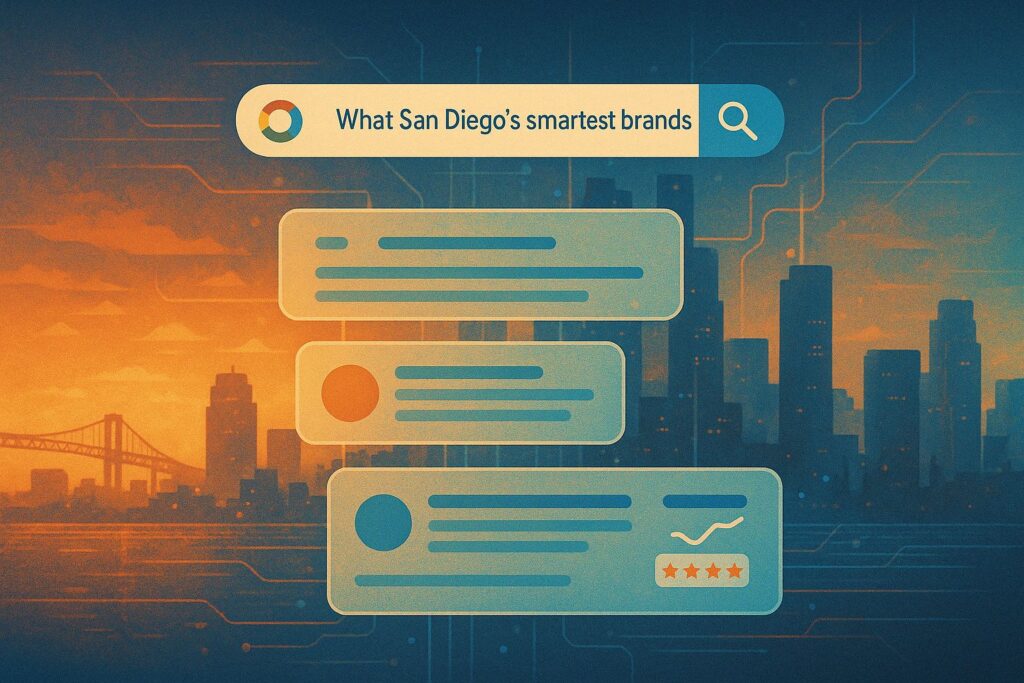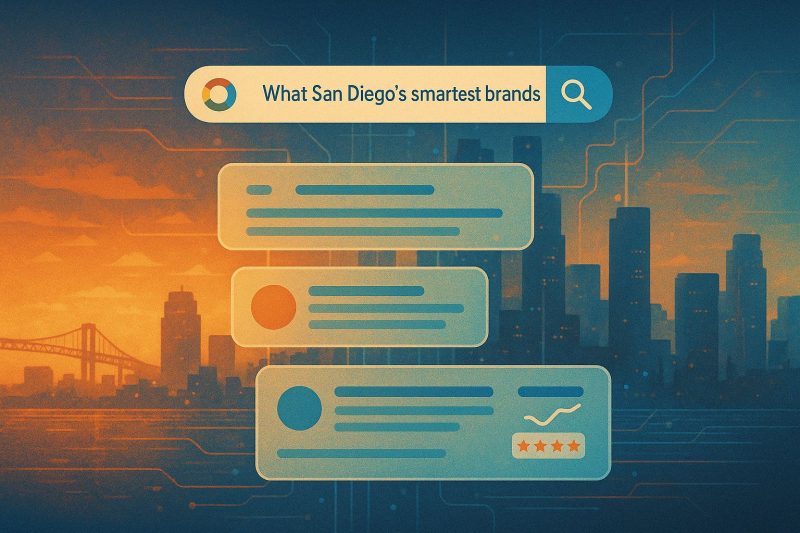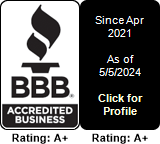The smartest brands in San Diego aren’t trying to “rank.” They’re building digital environments so natural, they feel like you were meant to find them. They don’t follow SEO trends. They build the ones others copy six months later.
They Don’t Just Rank. They Architect Discoverability
The smartest brands in San Diego don’t wake up thinking, “Let’s rank on Google.” Instead, they ask, “Where is our market already looking, and why aren’t we there yet?” Especially in high-stakes sectors like biotech and B2B software across Sorrento Valley, successful companies understand that SEO is not a checklist of tactics. It’s a strategic framework for becoming discoverable at every decision point. These businesses build with intention. They align their sitemap to reflect user behavior, not just category structures. They incorporate schema that positions their services within the broader biomedical and technology ecosystems, tying into knowledge graphs and structured web context. Instead of flooding their blog with low-intent content, they create knowledge hubs filled with whitepapers, technical briefs, and solution-driven articles connected through deliberate internal link logic. They track topic drift, build internal navigation that reflects user journeys, and prioritize informational clarity over buzzword saturation. Their SEO works in layers: technical health, semantic mapping, and narrative authority. They don’t hire vendors. They work with SEO architects who treat discoverability as infrastructure. They play the long game. The outcome is organic traffic that multiplies, sustains, and converts over time. These are the brands that understand visibility is a system, not a spike. They treat every click as a potential compounder.
They Localize SEO Like They Localize Coffee Menus
Ask someone in Hillcrest what makes a great flat white, and you’ll get a different answer than someone in Del Mar or Eastlake. San Diego’s neighborhoods are culturally, economically, and behaviorally distinct. The smartest brands mirror that in how they structure their SEO. They know local SEO isn’t just about showing up for “near me” searches. It’s about speaking the language of the neighborhood, understanding device preferences, urgency levels, and even how long people are willing to scroll. In North Park, mobile-first behavior and urgency lead to optimized map listings with click-to-call and review-rich GMB profiles. In Del Mar, where searches tend to happen on desktop during work hours, long-form service pages with appointment integration win the click. These brands don’t duplicate location pages across zip codes. Instead, they localize content down to landmarks, parking tips, neighborhood references, and custom FAQs. Their structured data reflects regional relevance, not just name, address, and phone. They create dynamic landing pages that cater to micro-markets within San Diego County. They use hyperlocal blog posts to fill contextual gaps between informational and transactional queries. For them, the city isn’t one audience. It’s dozens of overlapping behavioral maps. And they optimize accordingly. Whether it’s Hillcrest’s brunch crowd or Sorrento Mesa’s tech execs, these businesses don’t just show up. They show up right.
They Turn Traffic Into Tactics, Not Vanity Metrics
There’s no shortage of San Diego businesses bragging about their traffic. But look closer: how many of them are converting that traffic into actual customers? The smart ones understand that raw numbers don’t equal revenue. Contractors, dentists, and HVAC providers in East County know that a thousand visitors mean nothing if the phone doesn’t ring. That’s why they don’t stop at “good content.” They design for behavior. They analyze scroll depth, time-on-page, form completion drop-off, and CTA heatmaps. They ask: what happens after the click? Their websites aren’t brochures. They’re interactive funnels engineered to absorb users and nudge them toward contact, booking, or purchase. They build landing pages not around keywords but around decision points. If a homeowner in La Mesa is researching roof replacement, these brands present cost calculators, visual before-and-after projects, and financing options, on mobile-first, frictionless pages. When something underperforms, they don’t rewrite blindly. They map where intent and execution diverged. For them, SEO and CRO are inseparable. They’re not just getting found. They’re building outcomes. Their content is conversion-mapped, their forms are UX-tested, and their calls-to-action evolve based on heatmap data. This is what separates SEO amateurs from operators. It’s not traffic that grows your business. It’s what you do with it, and the smartest brands do a lot.
They Play the Algorithm Like a Seasonal Tide
For most businesses, a Google core update brings panic. For San Diego’s most sophisticated brands, it’s just another wave in the cycle. They’re already paddling. Whether it’s an ecommerce brand in Little Italy or a medical group in University Heights, those that thrive treat algorithm updates as part of the terrain. They don’t keyword-stuff, over-optimize, or chase trends. Instead, they monitor topical authority across clusters, refresh aging content monthly, and run technical audits like clockwork. When an update rolls out, they already know which pages might be at risk: thin content, misaligned intent, outdated internal linking. They adapt fast, shifting authority flow, consolidating cannibalized URLs, and pruning stale sections that no longer serve the user. Some even build version-controlled content repositories so they can A/B test post-update changes without guessing. These brands don’t view SEO as fragile. They see it as dynamic. They invest in redundancy: multiple entry points for every conversion goal, semantically varied anchor text, and layered navigation systems that reduce bounce. Their teams align editorial calendars with algorithm volatility patterns. They don’t just react. They prepare. The difference is foresight. While others suffer dips and wonder what changed, these operators surface stronger. Because they’re not optimizing for the last update. They’re building for the next one.
They Don’t Write Content. They Build Conversion Traps
The content playbook most San Diego businesses follow is broken: write a blog post, stuff some keywords, hit publish, and hope it ranks. The smartest brands shredded that manual years ago. Instead, they build what we call “conversion traps”—multi-format, intent-layered assets designed to capture and convert, not just inform. A wellness clinic in Pacific Beach might launch a deep-dive article on chronic pain management, but it doesn’t stop there. It includes interactive symptom quizzes, video case studies, downloadable guides, and embedded appointment widgets. All stitched together through strategic internal linking. A DTC apparel brand in Barrio Logan might build style guides that auto-update with seasonal product drops, feature user-generated lookbooks, and track CTA engagement through scroll-triggered modals. These brands understand that content is a system, not a sequence. They map out clusters weeks in advance, tie each piece to a query type, and link them in layered funnels. Their CMS isn’t just a blog backend. It’s a testing lab. Every title, heading, and visual element serves a purpose. Accessibility matters. Load speed matters. Schema matters. And so does narrative. Because Google isn’t the audience. Humans are. And in a city where attention is currency, these businesses use content to buy time, trust, and transactions.

Let’s Make Your Brand One of Them
You’ve now seen how San Diego’s sharpest operators treat SEO: not as a checklist, not as a ranking race, but as a system designed for growth, agility, and decision-making. If your current strategy still relies on blog churn, keyword stuffing, or templated audits, it’s time to rethink. The brands winning in San Diego don’t optimize for visibility. They engineer it. And the outcomes speak for themselves: traffic that converts, content that compounds, and strategies that survive every update. Ready to move beyond tactics and build a system designed to last? Partner with a San Diego SEO Company that treats organic not as a service, but as a growth engine.


